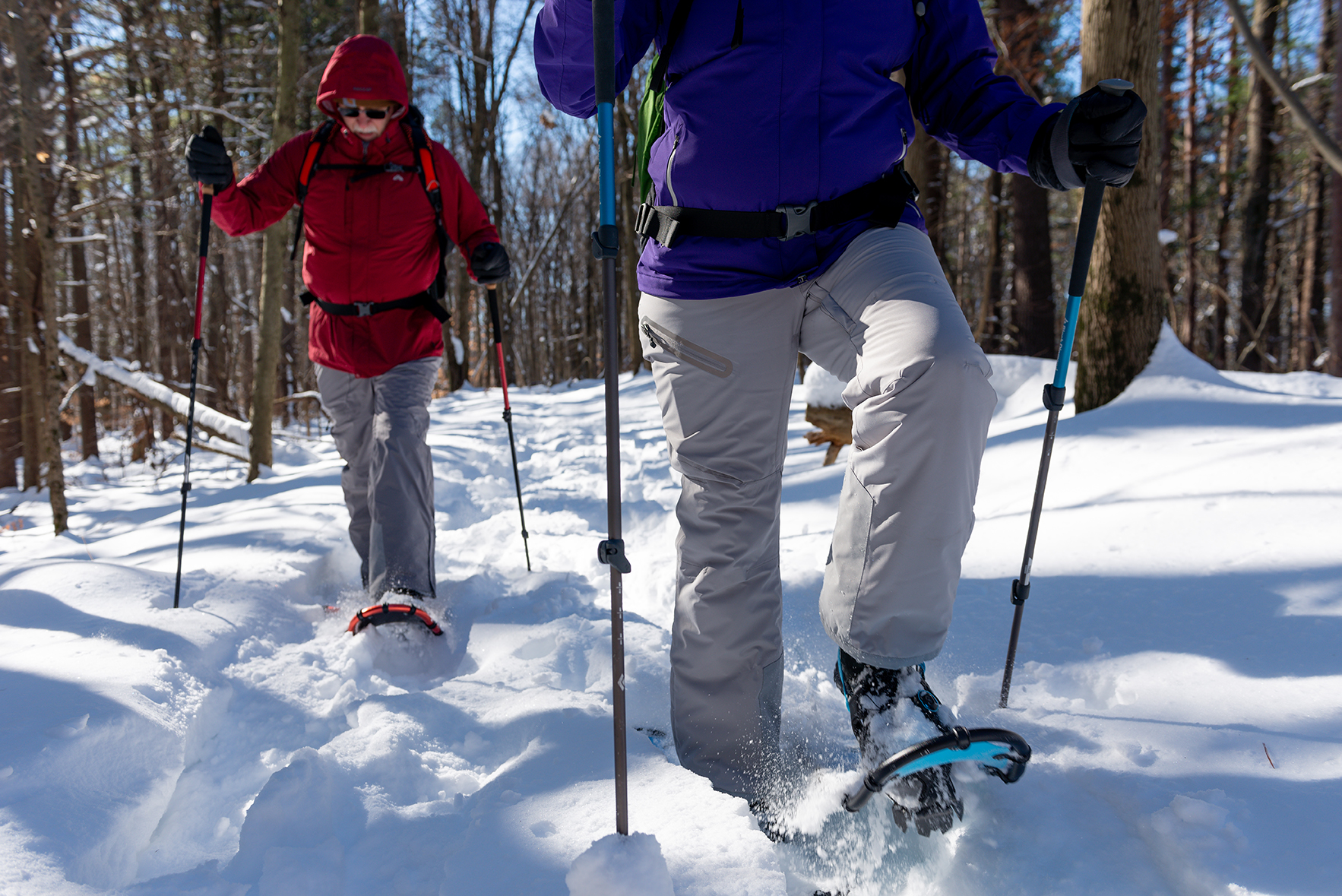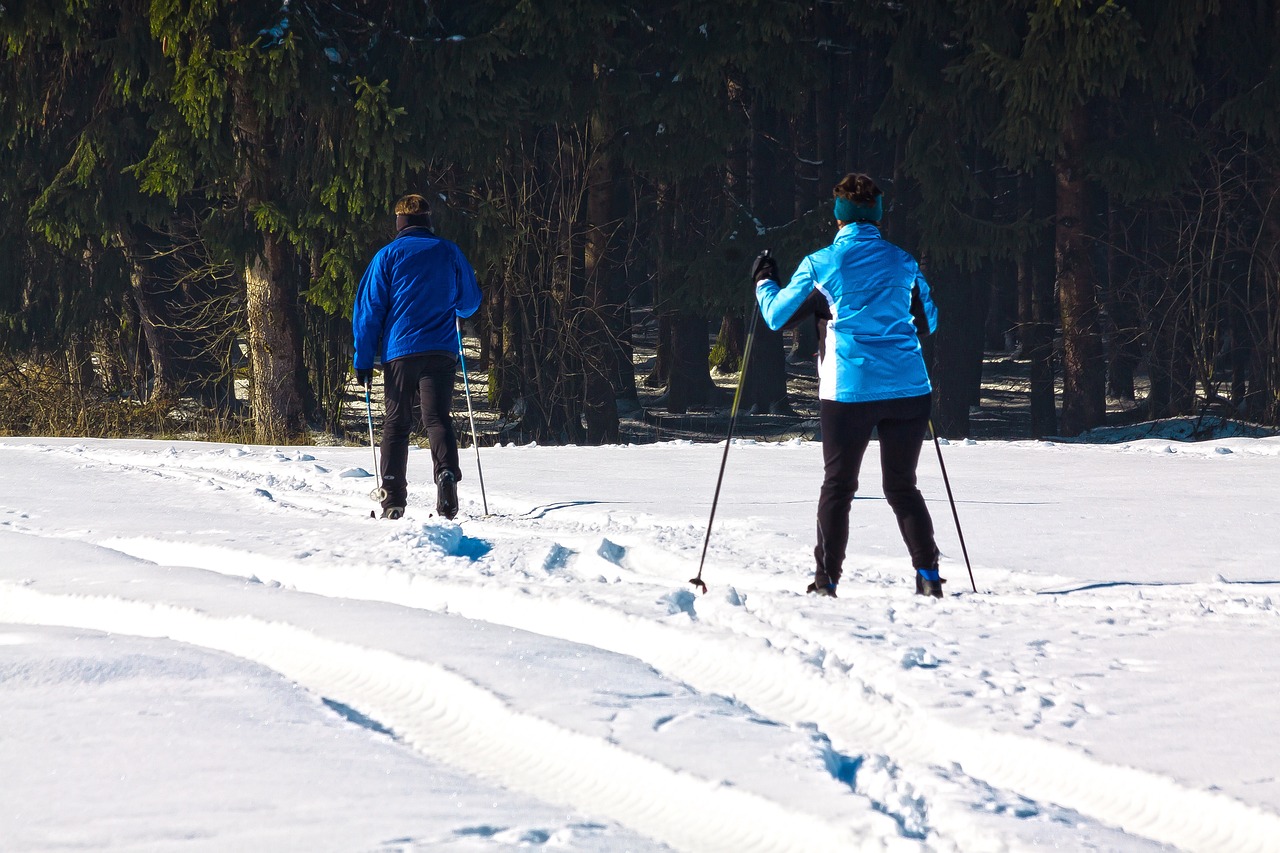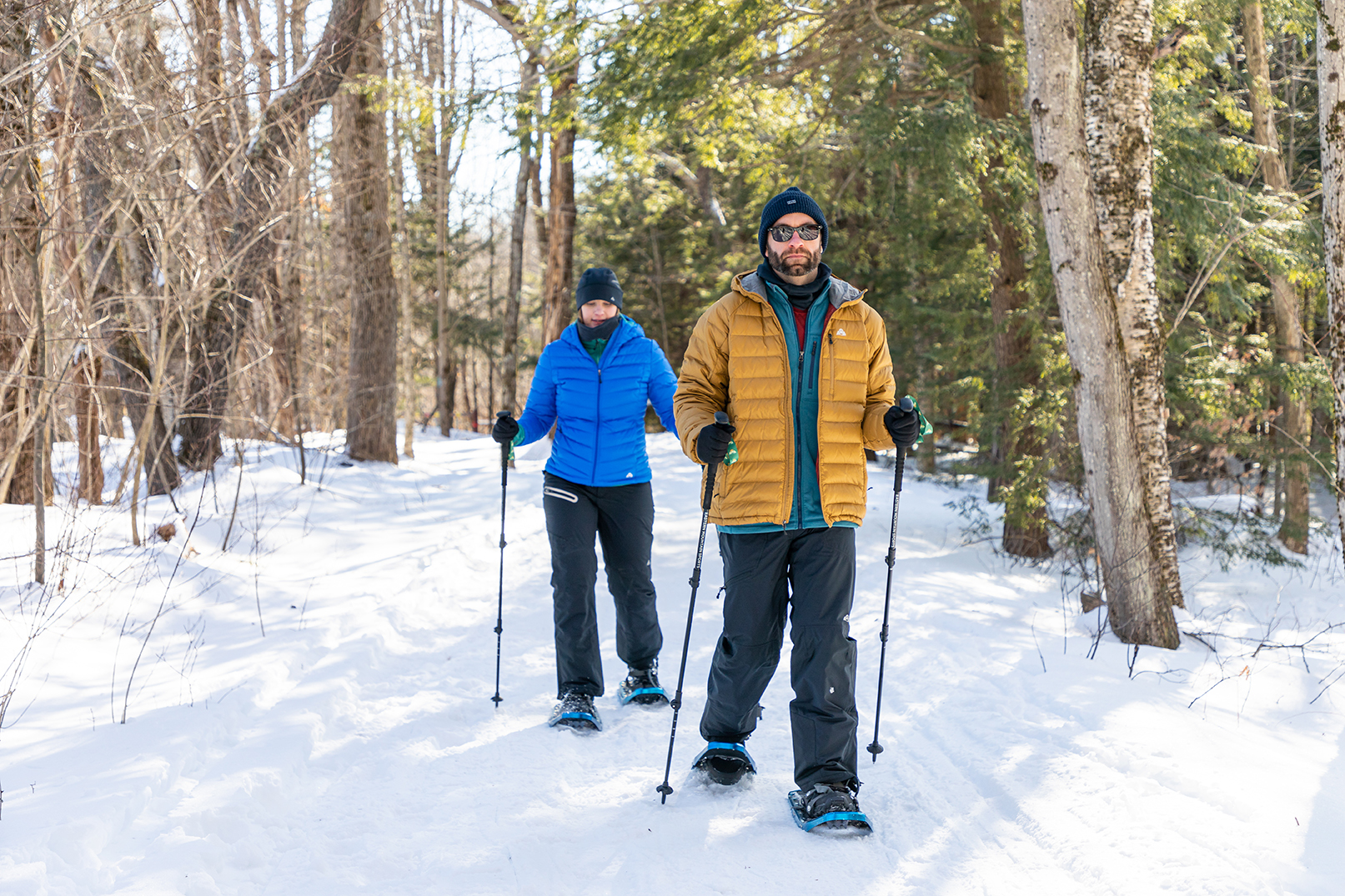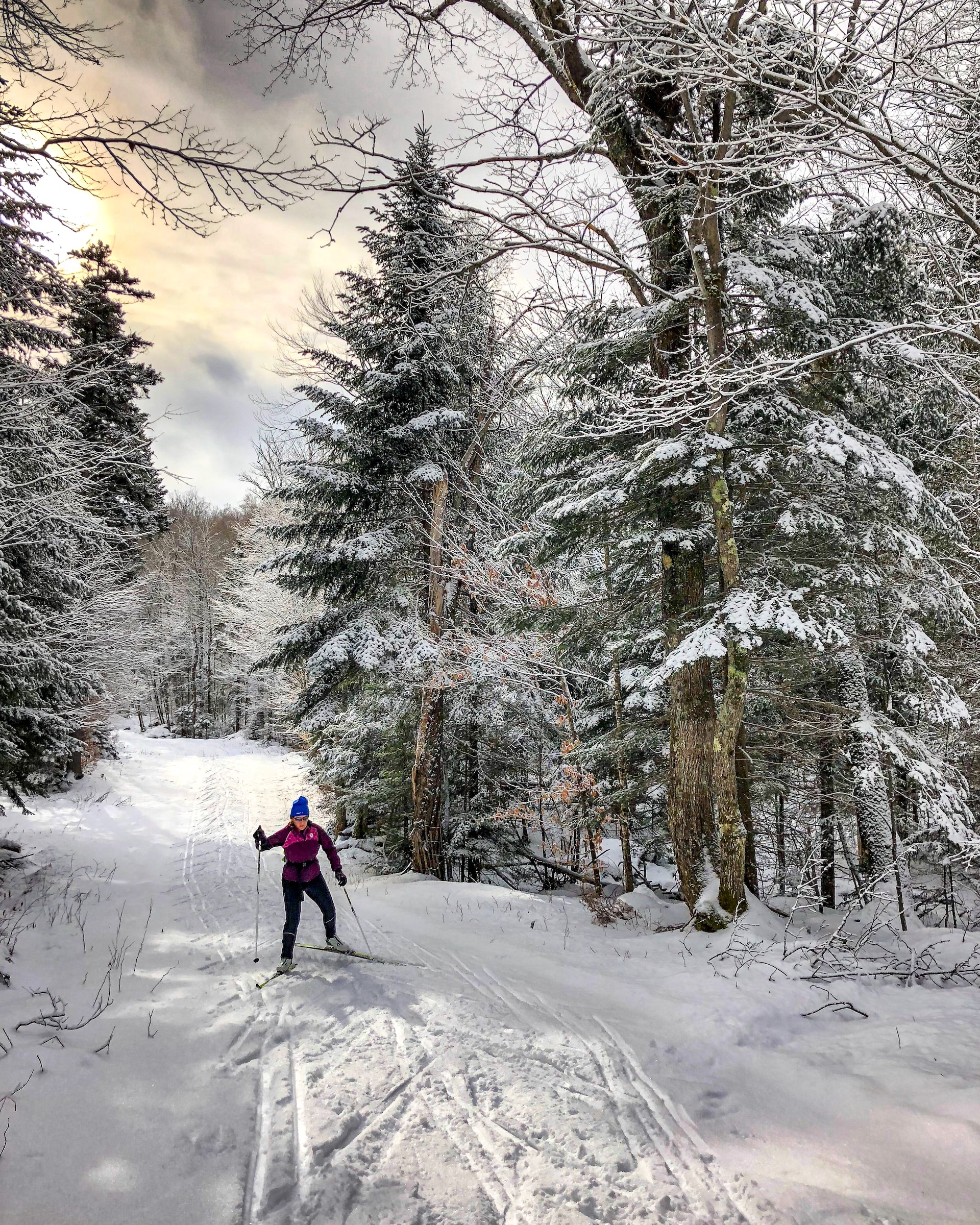Snowshoes and cross-country skis are two popular ways to explore the snow and get some exercise over the winter. Having trouble deciding what’s right for you, the stomp of snowshoes or the glide of skis? Here are a few things to consider when choosing between the two.
5 Reasons to Choose Snowshoes
Snowshoes are available in a variety of styles, from those meant for venturing into mountains to those aimed at exploring your backyard. That said, snowshoes all generally serve the same purpose: to provide floatation and keep you from sinking into the snow. Some of the advantages offered by snowshoes include:
1. Easier to Learn
There’s a lot of truth to the popular saying if you can walk, you can snowshoe. It’s simply faster to become proficient at snowshoeing than it is to get good at cross-country skiing. Snowshoeing only requires small adjustments to your normal gait to account for their additional width and length, which can make turning around and climbing slopes awkward at first.
2. Friendlier Learning Curve
Not only is snowshoeing easier to get started doing, but the learning curve is more gentle. Falls are uncommon and much less likely than when using cross-country skis. Moreover, any falls you do take on snowshoes are generally slow speed and less awkward. If you do happen to take a tumble, it’s much easier to right yourself on snowshoes, especially if you use poles.
3. More Affordable
Typically snowshoes are more affordable and there is less to buy than XC skis, which require skis, bindings, special boots, and poles. However, depending on how and where you’re planning on using your snowshoes, there’s a good chance you’ll want a waterproof pair (and maybe insulated) of boots and trekking poles.
4. Simpler to Transport
Most snowshoes easily fit in the backseat or trunk of your vehicle, making them easy to get from your garage or gear room to the trailhead, golf course, or wherever else you feel like stomping around. Skis, by contrast, may require a cargo box or ski rack (xx link to cargo box or ski rack article). Similarly, snowshoes are easier to store and take up less space in your home.
5. More Manageable
Snowshoes more easily adapt to different terrain than their XC ski counterparts. They’re easier to control in deep snow and readily negotiate obstacle-filled terrain—like a trail that weaves between rocks, trees, and underbrush. Snowshoes are also better suited to tackling steep inclines thanks to their cleats, which are more akin to crampons on some backcountry-focused pairs, and heel lifts, which are becoming an increasingly popular feature on all manner of snowshoes.
5 Reasons to Choose Cross-Country Skis
There are two main styles of cross-country skis: those designed for use in natural conditions and those intended for groomed trails, such as those found at touring centers like Bear Notch (xx link to article when published). For this article, I’ll primarily focus on touring skis—also known as backcountry skis—which are ideal for exploring fresh snow and, for most users, are a closer competitor to snowshoes than other types of XC skis (like skate and classic).
1. Cover More Terrain
Thanks to the glide of cross-country skis, they’re generally quicker than snowshoeing. If you like fast-paced activities and covering a lot of ground, XC skis may be for you. Consider that Simi Hamilton and Ben Koons came in second in the fabled Grand Traverse—a 40-mile ski race from Crested Butte to Aspen—on skate skis in a scorching fast 6:13:15.
2. Fantastic Workout
Cross-country skiing is exceptional aerobic exercise and incorporates seemingly every part of your body—your legs provide power; arms, shoulders, and back drive you forward; hips keep you stable; and core transfers power. As author Bill McKibben writes in his book Long Distance: Testing the Limits of Body and Spirit In A Year of Living Strenuously: “When exercise physiologists rank athletes by how much oxygen they can burn per minute, the biggest and best hearts and lungs in the world belong to the Norwegians, Finns, and Russians who win cross-country World Cups; they edge out even the great rowers and marathoners and Tour de France cyclists.”
3. Burn Calories
An hour of XC skiing at an elite level can burn 1,300 calories, the equivalent of what’s found in a Chipotle burrito. Even more modest XC skiers burn a lot of fuel—a recreational skier traveling at a reduced pace can burn more than 600 calories an hour. That’s a tasty snack at your favorite North Country coffee shop!
4. Low Impact
Since cross-country skiers glide across the snow, they don’t subject their bodies to the same pounding as other highly aerobic activities. The joint-friendliness of XC skiing—along with its fitness benefits—make it a popular alternative to running and walking in the winter.
5. Adrenaline Rush
Compared to alpine skiing, the hills encountered in XC skiing may seem minute—until you start picking up speed on sticks better suited to gliding across flat ground, rather than careening downhill, that is. It’s not just spicy descents that deliver a rush; those pushing the pace on their XC skis often report getting a “runner’s high,” the euphoric state that sometimes follows intense exercise.
Considerations When Buying Snowshoes or XC Skis
Tips for Buying Snowshoes
Heading to the store to pick out a pair of snowshoes? Here are a few tips to help you select the perfect pair of snowshoes for you.
- Go Small: Unless you’re planning to do extensive off-trail explorations, I recommend erring on the side of smaller snowshoes for use in the Northeast. It gets less snow than other regions and is often the recipient of heavy wet snow which requires less flotation. Smaller snowshoes provide many benefits, including being lighter and easier to walk in.
- Bring Your Boots: When looking at snowshoes, bring the boots you’re planning on wearing with them to ensure compatibility. There’s nothing more frustrating on a cold day than a snowshoe that won’t stay attached to your boot.
- Experiment with Bindings: Snowshoes come with a variety of different bindings—from old-school straps to snowboard-style ratchets to clever Boas. Find a binding style that is easy for you to operate and holds your boots snugly.
I also strongly recommend that snowshoers consider using a set of trekking poles. They help with balance and provide a more full-body workout. Just remember to equip poles with snow baskets, which are larger than standard baskets and help keep your poles from sinking in the snow.
Tips for Buying XC Skis
One of the best things you can do before buying XC skis is to understand the type of skiing you’re planning on doing. While touring skis are great for exploring your town forest or sliding around the local golf course, a skate or touring ski might be what you’re looking for if you aspire to glide on groomers.
- Try Before You Buy: Not sure what exactly you’re looking for? Rent some XC skis from your local outdoor store or visit a touring center and find out what type of XC skiing is appealing to you.
- Hunt for a Package: In general, XC skiing requires more gear than snowshoeing, however, many stores sell XC ski packages that have everything you need—skis, bindings, boots, and poles—in a bundle at a reduced price.
Remember to Have Fun
Whether you’re a devoted snowshoer or a committed XC skier, both activities get you outside, exercising, and hopefully having fun—all of which adds up to an exciting and active winter.
Luke Foley
Luke Foley is passionate about discovering and sharing hidden local treasures and has long been a New England adventure enthusiast. After all, there are only a few places where you can skin for fresh tracks in the morning and have a sunset surf session on the same day.








